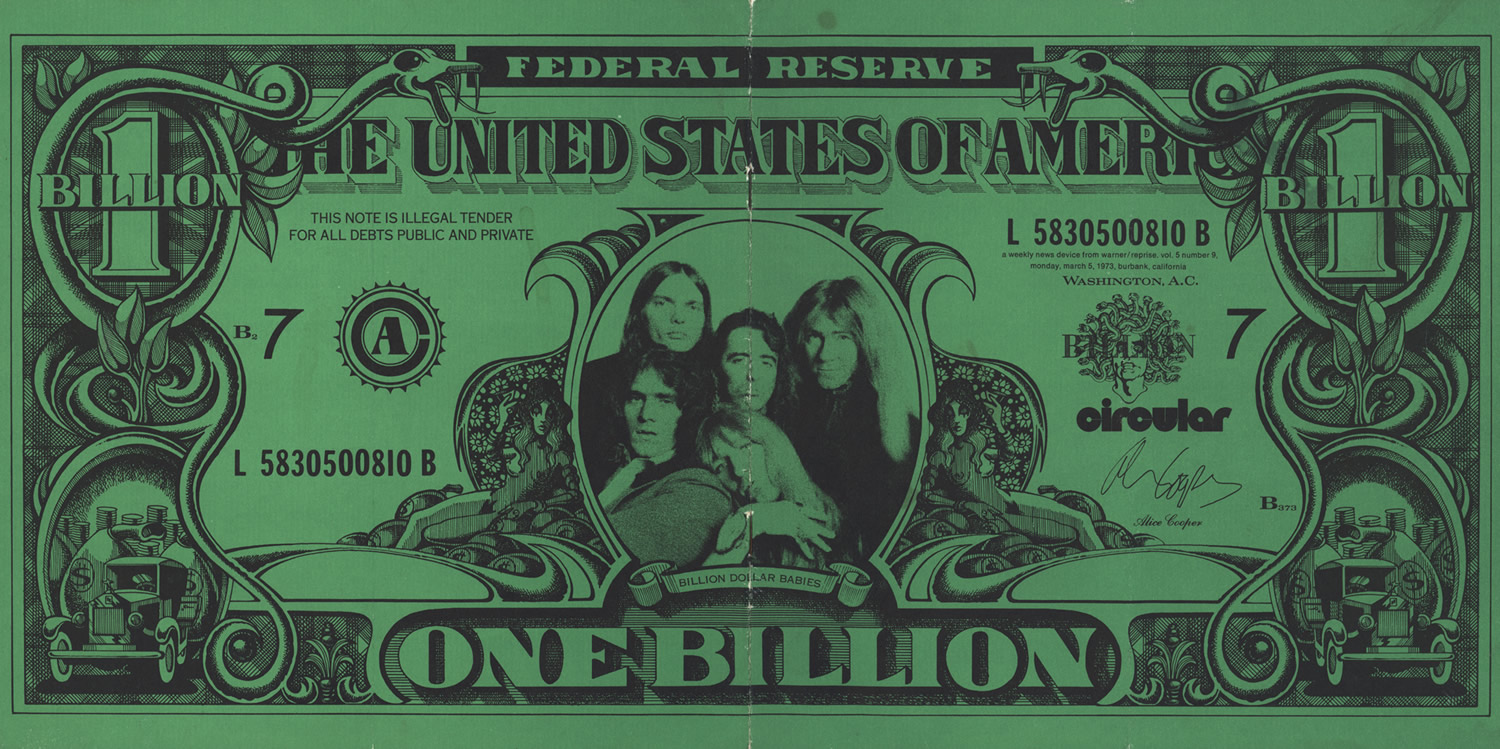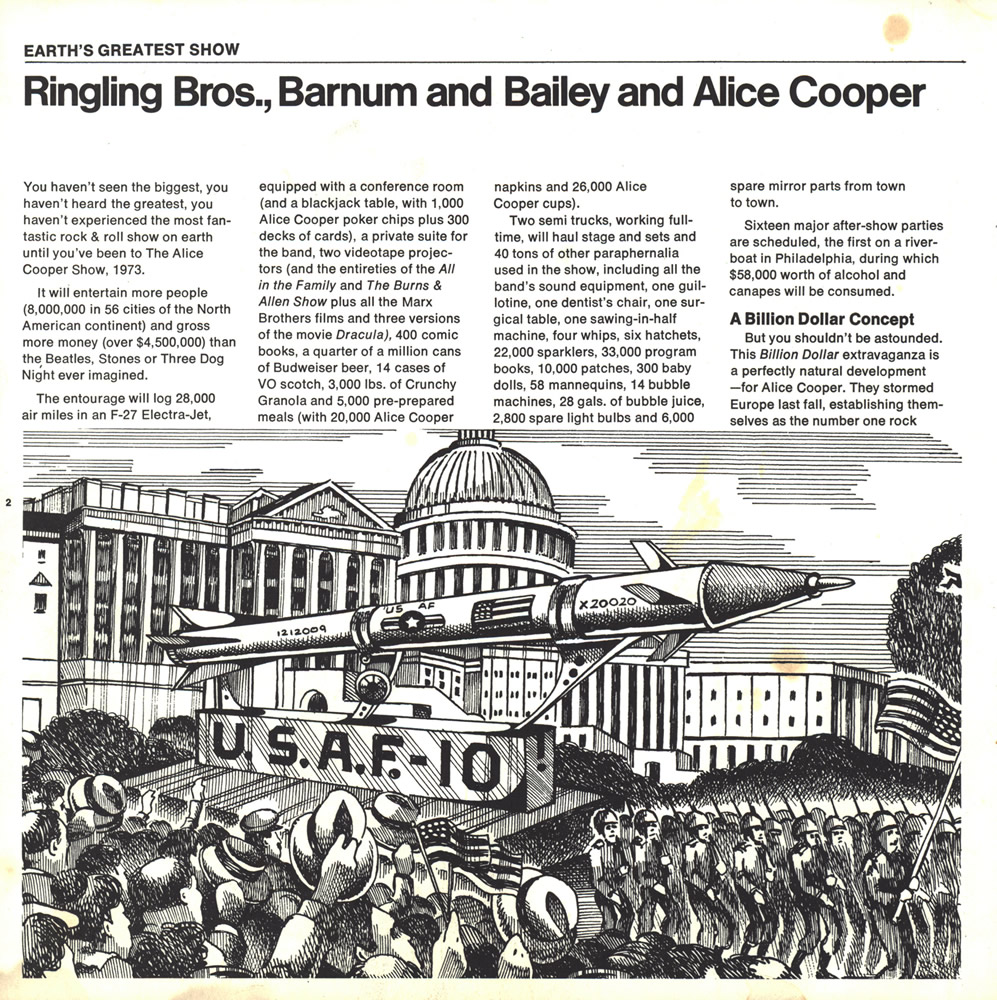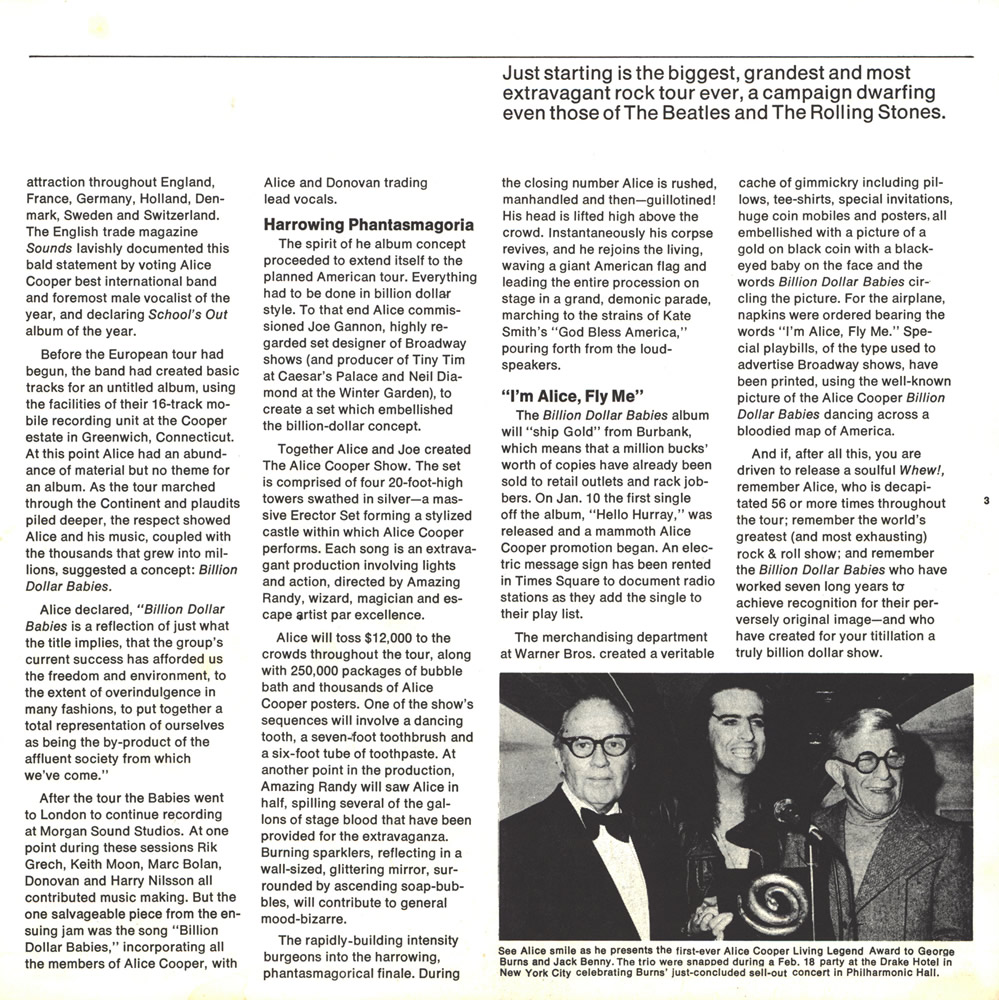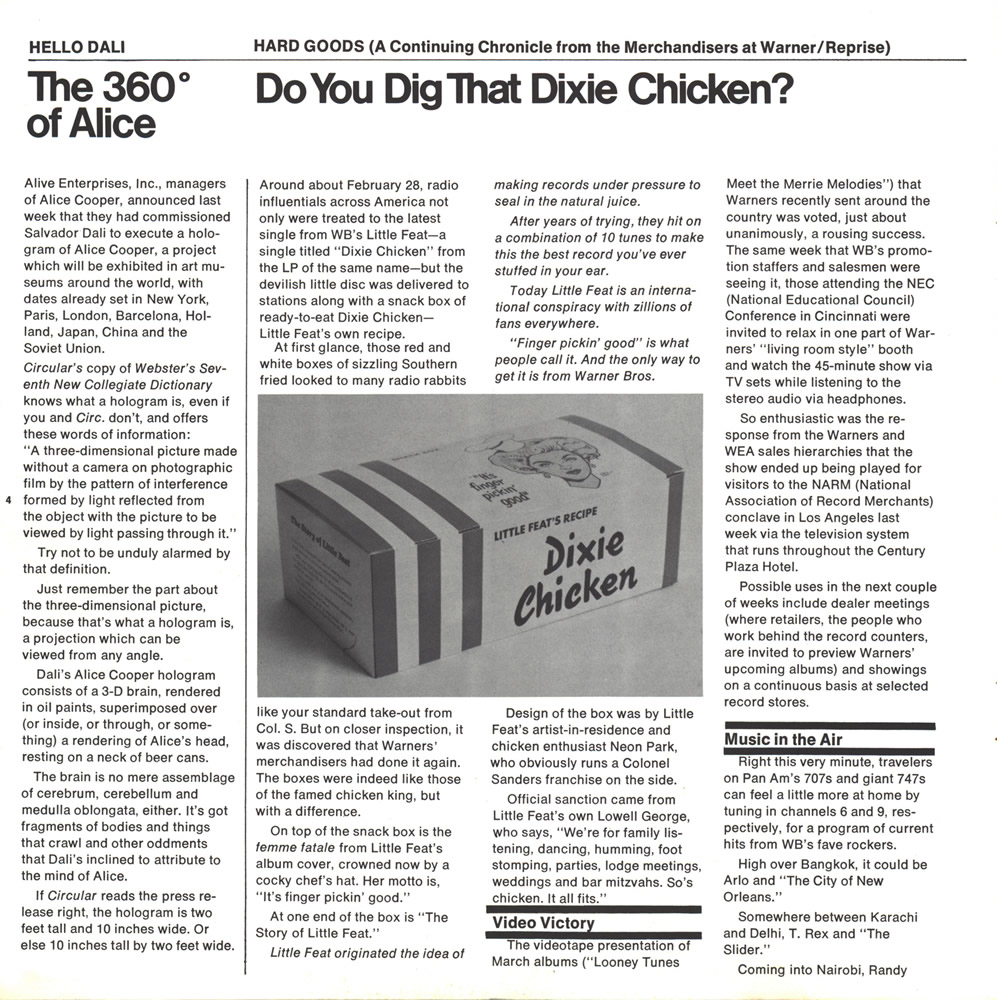Article Database

Circular
March 05, 1973
Ringling Bros., Barnum and Bailey and Alice Cooper
You haven't seen the biggest, you haven't heard the greatest, you haven't experienced the most fantastic rock & roll show on earth until you've been to The Alice Cooper Show, 1973.
It will entertain more people (8,000,000 in 56 cities of the North American continent) and gross more money (over $4,500,000) than the Beatles, Stones or Three Dog Night ever imagined.
The entourage will log 28,000 air miles in an F-27 Electra-Jet, equipped with a conference room (and a blackjack table, with 1,000 Alice Cooper poker chips plus 300 decks of cards), a private suite for the band, two videotape projectors (and the entireties of the All in the Family and The Burns & Allen Show plus all the Marx Brothers films and three versions of the movie Dracula), 400 comic books, a quarter of a million cans of Budweiser beer, 14 cases of VO scotch, 3,000 lbs. of Crunchy Granola and 5,000 pre-prepared meals (with 20,000 Alice Cooper napkins and 26,000 Alice Cooper cups).
Two semi trucks, working full time, will haul stage and sets and 40 tons of other paraphernalia used in the show, including all the band's sound equipment, one guillotine, one dentist's chair, one surgical table, one sawing-in-half machine, four whips, six hatchets, 22,000 sparklers, 33,000 program books, 10,000 patches, 300 baby dolls, 58 mannequins, 14 bubble machines, 28 gals. of bubble juice, 2,800 spare light bulbs and 6,000 spare mirror parts from town to town.
Sixteen major after-show parties are scheduled, the first on a riverboat in Philadelphia, during which $58,000 worth of alcohol and canapes will be consumed.
A Billion Dollar Concept
But you shouldn't be astounded. This Billion Dollar extravaganza is a perfectly natural development — for Alice Cooper. They stormed Europe last fall, establishing themselves as the number one rock attraction throughout England, France, Germany, Holland, Denmark, Sweden and Switzerland. The English trade magazine Sounds lavishly documented this bald statement by voting Alice Cooper best international band and foremost male vocalist of the year, and declaring School's Out album of the year.
Before the European tour had begun, the band had created basic tracks for an untitled album, using the facilities of their 16-track mobile recording unit at the Cooper estate in Greenwich, Connecticut. At this point Alice had an abundance of material but no theme for an album. As the tour marched through the Continent and plaudits piled deeper, the respect showed Alice and his music, coupled with the thousands that grew into millions, suggested a concept: Billion Dollar Babies.
Alice declared, "Billion Dollar Babies is a reflection of just what the title implies, that the group's current success has afforded us the freedom and environment, to the extent of overindulgence in many fashions, to put together a total representation of ourselves as being the by-product of the affluent society from which we've come."
After the tour the Babies went to London to continue recording at Morgan Sound Studios. At one point during these sessions Rik Grech, Keith Moon, Marc Bolan, Donovan and Harry Nilsson all contributed music making. But the one salvageable piece from the ensuing jam was the song "Billion Dollar Babies," incorporating all the members of Alice Cooper, with Alice and Donovan trading lead vocals.
Harrowing Phantasmagoria
The spirit of the album concept proceeded to extend itself to the planned American tour. Everything had to be done in billion dollar style. To that end Alice commissioned Joe Gannon, highly regarded set designer of Broadway shows (and producer of Tiny Tim at Caesar's Palace and Neil Diamond at the Winter Garden), to create a set which embellished the billion-dollar concept.
Together Alice and Joe created The Alice Cooper Show. The set is comprised of four 20-foot-high towers swathed in silver — a massive Erector Set forming a stylized castle within which Alice Cooper performs. Each song is an extravagant production involving lights and action, directed by Amazing Randy, wizard, magician and escape artist par excellence.
Alice will toss $12,000 to the crowds throughout the tour, along with 250,000 packages of bubble bath and thousands of Alice Cooper posters. One of the show's sequences will involve a dancing tooth, a seven-foot toothbrush and a six-foot tube of toothpaste. At another point in the production, Amazing Randy will saw Alice in half, spilling several of the gallons of stage blood that have been provided for the extravaganza. Burning sparklers, reflecting in a wall-sized, glittering mirror, surrounded by ascending soap-bubbles, will contribute to general mood-bizarre.
The rapidly-building intensity burgeons into the harrowing, phantasmagorical finale. During the closing number Alice is rushed, manhandled and then — guillotined! His head is lifted high above the crowd. Instantaneously his corpse revives, and he rejoins the living, waving a giant American flag and leading the entire procession on stage in a grand, demonic parade, marching to the strains of Kate Smith's "God Bless America," pouring forth from the loudspeakers.
"I'm Alice, Fly Me"
The Billion Dollar Babies album will "ship Gold" from Burbank, which means that a million bucks' worth of copies have already been sold to retail outlets and rack jobbers. On Jan. 10 the first single off the album, "Hello Hurray," was released and a mammoth Alice Cooper promotion began. An electric message sign has been rented in Times Square to document radio stations as they add the single to their play list.
The merchandising department at Warner Bros. created a veritable cache of gimmickry including pillows, tee-shirts, special invitations, huge coin mobiles and posters, all embellished with a picture of a gold on black coin with a blackeyed baby on the face and the words Billion Dollar Babies circling the picture. For the airplane, napkins were ordered bearing the words "I'm Alice, Fly Me." Special playbills, of the type used to advertise Broadway shows, have been printed, using the well-known picture of the Alice Cooper Billion Dollar Babies dancing across a bloodied map of America.
And if, after all this, you are driven to release a soulful Whew!, remember Alice, who is decapitated 56 or more times throughout the tour; remember the world's greatest (and most exhausting) rock & roll show; and remember the Billion Dollar Babies who have worked seven long years to achieve recognition for their perversely original image — and who have created for your titillation a truly billion dollar show.
The 360° of Alice
Alive Enterprises, Inc., managers of Alice Cooper, announced last week that they had commissioned Salvador Dali to execute a hologram of Alice Cooper, a project which will be exhibited in art museums around the world, with dates already set in New York, Paris, London, Barcelona, Holland, Japan, China and the Soviet Union.
Circular's copy of Webster's Seventh New Collegiate Dictionary knows what a hologram is, even if you and Circ. don't, and offers these words of information: "A three-dimensional picture made without a camera on photographic film by the pattern of interference formed by light reflected from the object with the picture to be viewed by light passing through it."
Try not to be unduly alarmed by that definition.
Just remember the part about the three-dimensional picture, because that's what a hologram is, a projection which can be viewed from any angle.
Dali's Alice Cooper hologram consists of a 3-D brain, rendered in oil paints, superimposed over (or inside, or through, or something) a rendering of Alice's head, resting on a neck of beer cans.
The brain is no mere assemblage of cerebrum, cerebellum and medulla oblongata, either. It's got fragments of bodies and things that crawl and other oddments that Dali's inclined to attribute to the mind of Alice.
If Circular reads the press release right, the hologram is two feet tall and 10 inches wide. Or else 10 inches tall by two feet wide.
(Originally published in Circular magazine — a weekly news device from Warner/Reprise — Vol. 5, Number 9; March 5th, 1973)






